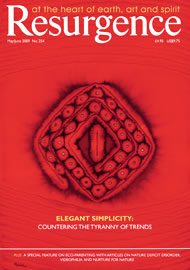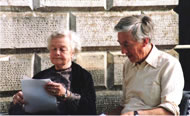THIS BOOK IS both a memoir and a group of testimonies. A memoir of Kathleen Raine, an original scholar, poet, and co-founder of the Temenos journal – but most of all a testimony to friendship. In fact, friendship is the abiding theme of this book, for as poet and novelist Jeremy Reed states, “Kathleen made friendship into an art.”
It was with a group of some of these friends that Raine started Temenos, initially a journal “devoted to the Arts of the Imagination”. The journal then evolved into an academy of scholars and teachers actively engaged in “the Perennial Philosophy” – the learning of the imagination. This perennial philosophy was Raine’s lifetime’s work. “She had set herself the difficult, perhaps impossible task,” explains Shusha Guppy, the Iranian singer and composer, “what she called ‘the battle’ on behalf of the imagination against the mindless materialism of the age.” The author John Michell recalls Raine as “a natural warrior, active in opposing the secularisation of culture… Against all modern fads – socialism, rational-positivism, egalitarianism, feminism – she upheld the superior claims of Nature, tradition and… love.”
Raine’s friendship was sought out by a truly diverse and acclaimed bunch of poets, musicians, writers and theologians. “Kathleen was, in essence, a kindred spirit whose brightly burning personality drew us, like moths, to her irresistible flame,” explains HRH The Prince of Wales. Once part of Raine’s circle, her friends were treated to a ritual of rigorous discussion and debate – and homemade cake.
Raine became a mentor for her family of kindred spirits, and, as Guppy reflects in her memorable entry, “in her rebelliousness, courage, intellectual rigour and staunch support of spiritual values, a model. Nor was I alone in such a relationship with her; she inspired the same mixture of affection and awe in her many younger friends and ‘protégés’.” The literary critic John Carey gives a strong idea of what this relationship meant for him: “To see scholarship of so high a standard being practised beyond the self-imposed frontiers of conventional academicism; to witness the insights which are gained by a humble attention to the wisdom of the great traditions; to learn of whole fields of knowledge which have been neglected or excluded by the universities – all this was manna in the wilderness.”
What I particularly liked about the memoirs is that although Raine is alluded to as a prophet she certainly is not painted as a saint. Only friends, not acolytes, can give the true service of honesty. Piloo Nanavutty’s vivid description of Raine is a case in point: “Her eyes, the colour of the tiny blue mignonette, could flash fire or cloud with tenderness. The sensitive mouth would dance with suppressed laughter or be set in a grim line of utter dislike.”
I became fascinated with the tiny vignettes painted of Raine’s home: the little table set for tea; the cosy sitting-room with its typewriter, books and reams of paper, a cat curled up in the corner; the chair in the garden under the shade of ancient camellias; the homemade madeleines, and the large orange chipped cooking-pot on the electric cooker. It was somehow comforting to know that not all poets live in garrets, wasting away in academic austerity. Descriptions of her kitchen are so wonderfully mortal. For, as painter and singer Thetis Blacker explains, “Kathleen saw the importance of cookery as a creative art of the imagination, like poetry, music and painting… Consequently she took as much trouble with every meal that she cooked, as with each poem that she wrote.” As Raine grew older, large dinner parties turned into tête-à-tête tea parties – described by many as occasions of “pure magic”. Those who were lucky enough to attend these “occasions” undoubtedly came away mentally nourished, and somehow sustained to get through the next weeks in the ‘outside’ world, before the next visit to 47 Paultons Square.
The strength of this book lies in the collection of its many different voices and writing styles. Sometimes the language is flowery and elusive, sometimes down to earth. Strangely enough, I found the occasional entries by Raine herself, expressing elements of what Temenos meant to her, the least accessible. Her style is dramatic and eloquent, but sometimes difficult to decipher. I gained most from the descriptions of her philosophy related second-hand through her devotees. In fact, the themes of the essays (spirit, the sacred, imagination, soul) are like a constant mantra, sung over and over again in different song-cycles and rhythms, decoding Raine’s philosophy and the work of the Temenos Academy. This is not repetitive, but rather reassuring, so as the book went on I felt imbued with a sense of the Perennial Philosophy, and began to grasp this nebulous, ancient wisdom.
Lighting a Candle gives a strong sense of Raine, her life, her ideas and her personality, through the reflections of her many dear friends. What comes over clearly is her enquiring mind and her commitment not just to an intellectual idea, but to something infinitely deeper and felt. As Raine said (impatiently, I imagine), not long before she died “Oh, how I wish people would stop learning ‘about’ things, rather than how actually to ‘be’ them.”
Sophie Poklewski Koziell is a freelance writer and co-author of Gathering Force.








